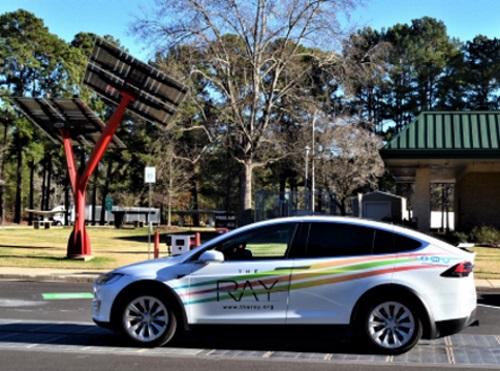The Georgia Department of Transportation is working with The Ray, Kia Georgia, and Panasonic to provide “ride-along” experiences along 18 miles of I-85 known as “The Ray Highway” to highlight the capability of vehicle-to-everything or V2X technology.
[Above photo by The Ray]
The four organizations said those ride along experiences aim to raise awareness among the public of the life-saving potential of connected vehicle technology as well as deploying real-world use cases with measurable benefits. Georgia DOT said V2X technology allows it to deliver “real-time situational awareness” to motorists along this corridor.
“It is important that Georgia DOT leads in the deployment of transportation technology that benefits all drivers, that helps to move freight across the region more efficiently and safely, and that advances Georgia as the technology epicenter of the east coast,” explained Russell McMurry, Georgia DOT commissioner, in a statement.
“We know that connected vehicle technology will save lives, and we are determined to see it come to life in Georgia as soon as possible,” he added. “Today is all about the power of partnerships and what we can accomplish for Georgians when we partner with organizations like Kia, The Ray, and Panasonic to advance our roadways.”
The “ride-along” experiences demonstrate how connected vehicle technology can detect and warn drivers about weather events, work zones, hard braking, and even vehicle crashes in a real-world highway environment.

The experience includes an in-vehicle visualization of traveler warnings, the capabilities of V2X technology installed on and along roadways, the digital communication that enables the intelligence of connected roadways, as well as how Panasonic’s Cirrus cloud platform “point of view” V2X system manages data for Georgia DOT in order to detect events and provide real-time alerts to drivers.
“Connected vehicle technology creates an extraordinary opportunity to increase travel efficiency and driver safety, simultaneously,” said Allie Kelly, executive director of The Ray, a corporate venture devoted to roadway technology testing.
“With great opportunity comes the responsibility to make investments in the physical and digital infrastructure that is necessary to enable the best that connected and autonomous vehicles have to offer,” she added.

“Georgia DOT and The Ray have made those investments in order to improve and modernize Georgia’s transportation infrastructure, and to offer the traveling public real time, real place warnings about critical driving conditions such as crashes, construction work zones, hard braking, and weather impacts like black ice, flooding and hydroplaning,” Kelly noted.
In January, the National Transportation Safety Board recently released a four-part video interview series examining the potential benefits and current “maturity level” of vehicle-to-everything or V2X technology.
NTSB Board Member Michael Graham conducted the video interviews and talked with Scott Marler – director of the Iowa Department of Transportation – and John Hibbard, operations division director for the Georgia Department of Transportation, about state-level V2X infrastructure deployment needs.
Marler – appointed by the American Association of State Highway and Transportation Officials to chair its Committee on Transportation System Operations in October 2020 – stressed that V2X holds the promise of vastly improving highway safety.
“State DOTs are interested in types of advanced technologies like V2X because they collectively hold the potential to reduce crashes by as much as 80 percent – we are not aware of any other approach that even comes close to promise of these technologies,” he said.
 Nation
Nation
The Stream by AASHTO: Electrified Roadway Testing
December 5, 2025 Nation
Nation

